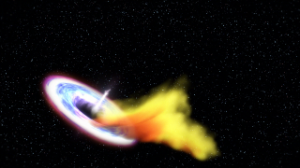TUESDAY, 22 NOVEMBER 2011
Most large galaxies orbit a supermassive black hole. However, how and why these huge interstellar objects grow to be millions of times the mass of our Sun remains a mystery. Studying the behaviour of junior or ‘intermediate mass’ black holes could shed new light on this topic, but such black holes are hard to detect.As orbiting stars stray too close to a black hole, they are ripped part by its enormous gravitational pull. Sometimes, only part of the star’s matter falls into the black hole; the remaining stellar material enters a chaotic orbit, crashing into itself and generating intense radiation known as a tidal disruption flare (TDF).
The radiation produced by TDFs is proportional to the mass and spin of the black hole, and would help us to understand how black holes grow from intermediate mass to supermassive. Until now, detecting TDFs has been difficult - they are very rare and the radiation they produce is similar to that generated by the much more common supernova (an exploded star) or quasar (a black hole surrounded by and consuming a gas and dust cloud).
However, a recent publication in Astrophysical Journal describes how Sjort van Velzen and colleagues have now developed a new telescopic method for detecting TDFs based on the colour of the flare. While supernovae and quasars generate blue flares that rapidly fade to red, TDFs remain blue and are slow to decay. It is hoped that continued research into TDFs will aid our understanding of how intermediate mass black holes form and grow.
Written by Joanna-Marie Howes
DOI: 10.1088/0004-637X/741/2/73

